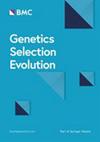Genetic parameters and potential of reducing tail and ear damage in pigs through breeding
IF 3.1
1区 农林科学
Q1 AGRICULTURE, DAIRY & ANIMAL SCIENCE
引用次数: 0
Abstract
Ear and tail biting are behaviours in pigs that cause both welfare problems and financial losses. Data collection of behaviour is difficult at the large scale needed for breeding. The damage inflicted on victims can, however, serve as a proxy for animal breeding. Here, we analysed tail and ear damage scores on their original scale, binary scale, and summed versions of these damage traits to investigate which trait definition is best for genetic selection. Using data from six purebred lines (33,329 animals in total) we aimed to (1) estimate genetic parameters for ear and tail damage using direct genetic models, (2) estimate the genetic correlation between tail and ear damage, (3) compare different trait definitions and their impact on accuracy, dispersion, and bias of estimated breeding values (EBV), and (4) compare expected responses to selection for each trait definition. The heritability of the damage traits ranged from 0.04 to 0.06. Ear and tail damage were moderately correlated (0.41–0.45), meaning that the genetic propensity of being a victim is a different trait for tail versus ear biting. Estimates of the accuracy of the EBV for the traits with a five-fold cross-validation and the linear regression method based on pedigree relationships ranged from 0.27 to 0.57, the dispersion from 0.91 to 1.18, and the bias was negligible. With a selected proportion of 5%, genetic progress of ~ 0.20–0.78 genetic standard deviations per generation can be reached, depending on the trait. It was trait dependent whether direct or indirect selection yielded the most response. Ear and tail damage are heritable traits and are moderately positively correlated. The EBV for the evaluated traits related to ear and tail damage showed moderate accuracies, minor dispersion, and no bias. We hypothesize that from a welfare perspective, ear and tail damage on the original scale are the relevant breeding goal traits. For ear damage on the original scale, the highest response to selection can be expected when selecting on the trait itself, whereas for tail damage on the original scale, selection on summed damage showed the highest gain. Results from this study show that genetic improvement of the direct genetic effect of ear and tail damage is possible.通过育种减少猪尾耳损伤的遗传参数和潜力
咬耳朵和咬尾巴是猪的行为,会造成福利问题和经济损失。繁殖所需的大规模行为数据收集是困难的。然而,对受害者造成的伤害可以作为动物繁殖的代表。在这里,我们分析了尾巴和耳朵在原始尺度、二值尺度上的损伤分数,并对这些损伤性状进行了总结,以研究哪种性状定义最适合遗传选择。利用6个纯种品系(共33,329只动物)的数据,我们旨在(1)利用直接遗传模型估计耳朵和尾巴损伤的遗传参数,(2)估计尾巴和耳朵损伤之间的遗传相关性,(3)比较不同性状定义及其对估计育种值(EBV)的准确性、分散性和偏差的影响,以及(4)比较每种性状定义对选择的预期反应。伤害性状的遗传力在0.04 ~ 0.06之间。耳朵和尾巴的损伤是中度相关的(0.41-0.45),这意味着作为受害者的遗传倾向是咬尾巴和咬耳朵的不同特征。5倍交叉验证和基于家系关系的线性回归方法估计的EBV精度范围为0.27 ~ 0.57,离散度范围为0.91 ~ 1.18,偏差可以忽略不计。选择比例为5%时,根据性状的不同,每代遗传进步可达0.20 ~ 0.78个遗传标准差。直接选择和间接选择产生的反应是性状决定的。穗尾损伤是遗传性状,具有中度正相关。耳尾损伤相关性状的EBV精度中等,离散度小,无偏倚。我们假设从福利角度来看,原始规模的穗尾损伤是相关的育种目标性状。对于原尺度的耳损,选择性状本身的选择响应最高,而对于原尺度的尾损,选择性状总和的选择增益最高。结果表明,对穗尾损伤的直接遗传效应进行遗传改良是可能的。
本文章由计算机程序翻译,如有差异,请以英文原文为准。
求助全文
约1分钟内获得全文
求助全文
来源期刊

Genetics Selection Evolution
生物-奶制品与动物科学
CiteScore
6.50
自引率
9.80%
发文量
74
审稿时长
1 months
期刊介绍:
Genetics Selection Evolution invites basic, applied and methodological content that will aid the current understanding and the utilization of genetic variability in domestic animal species. Although the focus is on domestic animal species, research on other species is invited if it contributes to the understanding of the use of genetic variability in domestic animals. Genetics Selection Evolution publishes results from all levels of study, from the gene to the quantitative trait, from the individual to the population, the breed or the species. Contributions concerning both the biological approach, from molecular genetics to quantitative genetics, as well as the mathematical approach, from population genetics to statistics, are welcome. Specific areas of interest include but are not limited to: gene and QTL identification, mapping and characterization, analysis of new phenotypes, high-throughput SNP data analysis, functional genomics, cytogenetics, genetic diversity of populations and breeds, genetic evaluation, applied and experimental selection, genomic selection, selection efficiency, and statistical methodology for the genetic analysis of phenotypes with quantitative and mixed inheritance.
 求助内容:
求助内容: 应助结果提醒方式:
应助结果提醒方式:


